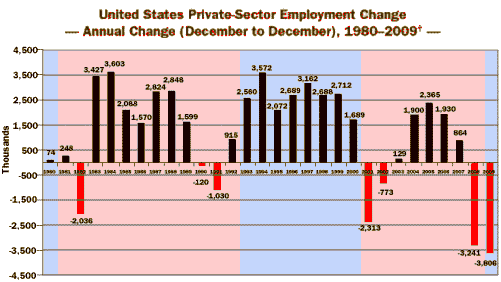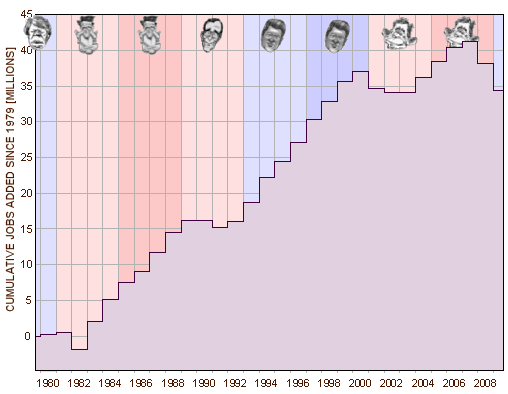| "As of August 2009, the nation had 1.3 million (1,256,000) fewer private sector jobs than in December 1999. This is the first time since the Great Depression of the 1930s that America will have an absolute loss of jobs over the course of a decade." |
This all feels like something we’ve all known about for years. We drive Japanese, German, and Korean cars, run them with Saudi Oil, use Japanese cameras, work with Chinese tools, wear Indonesian clothes, call India for help on our Taiwanese computers, eat South American fruits and vegetables, etc. It seems like we’d figure out that being part of the New World Economy would sooner or later require us to do something other than simply be the world’s customer. Maybe we ought to make some things ourselves so that the vast majority of Americans who aren’t living the good life might have something to do with their time – like work at a job.

This graph is from the School of Planning and Public Policy at Rutgers University titled, America’s New Post-Recession Employment Arithmetic [I’ve added the shading to identify the political party in charge]. For starters, it shows the magnitude of the job loss during this Managed Depression compared to recent Recessions [note they’re still calling it a recession – my renaming must’ve come after their report]. But their reason for constructing this graph is to show how weak our recovery was after Bush II’s first Recession. Bush II’s track record is indeed poor – the most downs, the biggest downs, the least ups, the lamest ups, barely breaking even during his terms and leaving with a big bang. Here’s their graph redrawn as cumulative jobs added:

Executive Summaryâ’ The Great 2007–2009 recession is the worst employment setback in the United States since the Great Depression. In the twenty months from December 2007 (the start of the recession) to August 2009 (the last month of available data as of this analysis), the nation lost more than 7.0 million private-sector jobs.
â’ The recession followed a very much-below-normal economic expansion (November 2001–December 2007) that was characterized by relatively weak private-sector employment growth of approximately 1 million jobs per year. This was less than one-half of the job-growth gains of the two preceding expansions (1982–1990 and 1991–2001), when average annual private-sector employment grew by 2.4 million jobs per year and 2.2 million jobs per year, respectively.
â’ This underperformance cannot be appreciably attributed to slower labor force growth, i.e., workforce shortfalls. In the preceding two expansions combined, private-sector employment growth per year was approximately 435,000 jobs higher than the annual growth in the number of people in the labor force. In contrast, in the 2001–2007 expansion, private-sector employment growth was 550,000 jobs lower than the growth in the number of people in the labor force.
â’ The combination of a weak economic expansion sandwiched between two recessions (2001, and 2007–2009) produced what will be a lost employment decade. As of August 2009, the nation had 1.3 million (1,256,000) fewer private sector jobs than in December 1999. This is the first time since the Great Depression of the 1930s that America will have an absolute loss of jobs over the course of a decade.
â’ To put this new millennium experience into perspective, during the final two decades of the twentieth century, the nation gained a total of 35.5 million private-sector jobs. During the current decade, America appears destined to lose more than 1.7 million private-sector jobs.
â’ Because of the severity of the 2007–2009 recession employment losses (–7.0 million private-sector jobs as of August 2009), the United States faces a significant employment deficit as it confronts the realities of a postrecession future.
â’ Unfortunately, the job deficit is actually larger than the recession employment loss since long-term, demographically driven labor force growth has continued, even though the pace of this growth may have been temporarily muted by people discouraged from entering or returning to the labor force because of the depth and duration of recent job losses.
â’ The U.S. Bureau of Labor Statistics projects the nation’s labor force to grow by approximately 1.3 million persons per year between 2006 and 2016. Therefore, the nation has to add 1.3 million total jobs per year— consisting of private-sector and government payroll employment as well as contract (nonpayroll) payroll) employment—simply to accommodate a growing labor force.
â’ This 1.3 million annual increase in the labor force means that in terms of private-sector payroll employment, the nation has to create an estimated 920,000 jobs per year.2 Adding this to the actual private-sector job losses accumulated during the 20 months (to date) of recession equates to an August 2009 employment deficit of 8.6 million jobs. Given conservative estimates of further employment declines (even if the recession ends in the third quarter of 2009) and the continued increase in the labor force, the nation’s employment deficit could approach 9.4 million private-sector jobs by December 2009.
â’ Erasing this deficit will require substantial and sustained employment growth. Even if the nation could add 2.15 million private-sector jobs per year starting in January 2010, it would need to maintain this pace for more than 7 straight years (7.63 years), or until August 2017, to eliminate the jobs deficit! This is approximately 50 percent greater than the length of the average post–World War II expansion (58 months).
â’ Under these reasonable (and possibly even optimistic) conditions, it will take deep into the second decade of the new century for the labor market of the United States to return to where it was in December 2007, the start of the Great Recession. This basic post-recession arithmetic lesson is a very harsh one.
[…] Boring Old Man « our managed depression 2: ‘a lost employment decade’… our managed depression 3: […]
Now I know why they call it a depression. This is very depressing. And it is especially depressing to realize that you said something yesterday, I believe, that is very true. Obama likely cannot be the great president he could have been if he didn’t have to deal with this and all the other messes left to him to clean up.
Of course, there will be greatness in managing the mess better than others would have done. But he will not be able to accomplish what he could otherwise have done.
It is depressing. In fact, I don’t enjoy writing things like this because the only thing to say about it can’t be written – only felt. Such a legacy!
I started writing this, so I’ll finish it:
It’s very difficult to be the least empathic with dubya, but maybe he felt that way too, when 9/11 forced him to deal with something that wasn’t part of his plan.
And then I realized, mid-writing, that this fit very nicely into his plan — or rather his VP’s plan.
It did give them something to do after all Ralph. Prior to 9/11, Dubya’s singular accomplishment was to create the Office of Faith Based Initiatives. The Vice President accomplished an ultra-top secret meeting with the energy lobby, and according to Paul O’Neill and others, they were all pretty much focused on how to ignore anyone connected with the Clinton administration and get cracking on their Iraq initiatives….the sabers were rattling. Little wonder that the “truther” movement emerged…the inmates were running the asylum and it turned out quite badly didn”t it? Too bad for us that it didn’t follow the script of “King of Hearts” a bit more closely.